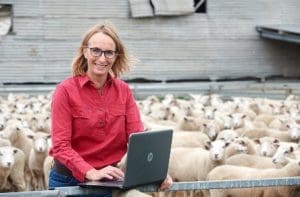
Georgina Gubbins Picture – MLA.
LOWER rainfall in two of the past three years has forced Heywood district prime lamb and beef producer Georgina Gubbins to increase forward management planning.
While the area’s average rainfall of 1000mm sounds luxurious to some, it doesn’t tell the full story of Georgina Gubbins’ farming environment.
“Two of the past three years have had the bottom percentile of rainfall, while 2016 was in the top percentile,” she said.
It also means waterlogged pastures in winter with slow dry matter production.
Georgina runs 800 Angus cattle and 4000 composite ewes on 970ha at Heywood, in southern Victoria. She was one of the first participants in the More Lambs More Often program, which is funded by the Australian Government and based on tools and modules in MLA’s Making More From Sheep.
A planned and proactive approach
“The result is we’ve become more proactive in our approach to seasons and managing our flock,” she said.
“We have trigger points in our business – they’re like gates, we either stop or go, depending on what is happening.
“We used to be much more reactive,” she said.
“We would wait to see what happened and make decisions as we went along.
“Now, we do a lot more forward planning.”
Click here to get the latest Sheep Central story links sent to your email inbox.
Scanning powers decisions
Ewe scanning is a central component of the Georgina’s approach to management. On scanning in June, ewes are drafted into empties, singles, twins and triplets. Priority for feed and shelter is given to triplets, then twins and then singles.
“I used to hate (managing ewes carrying) triplets, but now we’ve had up to 230 percent lamb marking from our triplet mob,” Georgina said.
“Every ewe in the triplet mob has at least twins and many raise triplets.
“Overall, our lamb marking is around 150–160pc across all the mobs.”
Scanning also tells Georgina how many head she will have on the ground in spring. That information, combined with weather forecast data from seven different climate models, helps with decision making, such as whether to buy in supplementary feed prior to September.
When seasons are tight…
Climate forecasts provide a trigger point for partial destocking in a tight season.
“We have what we call ‘black tag’ ewes – they’re the ewes that, if the season isn’t going the way we want, are the first to go,” Georgina said.
This group generally includes older ewes or poor performers.
“This also helps with shearing, because the ‘sell stock’ is the first to be shorn.”
“Markets are important, so from the get-go we look at how many lambs we might need to sell to stores and how many we’ll keep to finish in the paddocks,” she said.
Stock are paddocked so they can be easily accessed for sale without too much more handling or time spent going through multiple ewes.
“Really, it’s all about better planning. It’s not harder to do, it just requires being better organised,” Georgina said.
Lessons learned
Scanning leads to planning.
Establishing climatic trigger points provides structure.
Being well organised underpins decision making.
Source: MLA.

HAVE YOUR SAY